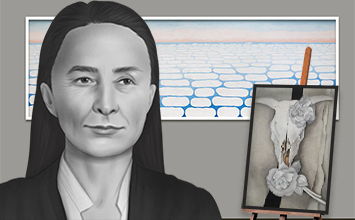Mary
Edmonia Lewis, known more commonly as Edmonia Lewis, was the first
professional sculptor of African and Native American descent in
America. She created Neoclassical sculptures deeply embedded with
racial themes and symbols. Lewis's most celebrated work is her Death
of Cleopatra (shown below). This
sculpture was displayed as a part of the 1876 Philadelphia Centennial
Exposition, where Lewis was one of a handful of women showcasing
their work. Of these few women, Lewis was the only one who was not
white, making her a paramount that paved the way for women artists of
color in the art world. The strong, ethnically-aware subject matter
of Death of Cleopatra makes
its inclusion in the exposition even more profound.
Wednesday, April 17, 2019
The Role of Race in Edmonia Lewis's Death of Cleopatra
This post is an updated and expanded form of an essay that I wrote in my college Women in Art class! I am excited to share some expanded and edited versions of my essays here (since I did spend plenty of time working on them, and I'd hate for them to rot away in my hard drive forever!)
Wednesday, November 7, 2018
Image Surfacing: An Example of Lee Krasner's Nonfeminist Art
 |
| Source |
A constant struggle for women artists throughout history has been the
question of their sex: does a woman have the same capacity to create
art as men? Does subject matter differ between men and women? At what
point is a line drawn where gender is no longer a consideration in
the evaluation of an artwork and the full focus lies on the artwork
itself? During the Modern Era of Art, there were two groups with very
strong opinions: the Separatists, who held very
anti-patriarchy/pro-matriarchy views and expressed extreme favoritism
for female and feminine subject matter, and the Nonfeminists who
simply wanted to be accepted artists without the modifiers of “woman”
or “female” in relation to their capability or criticism.
Abstract Expressionist painter Lee Krasner belonged to the latter of
the two groups.
Wednesday, October 3, 2018
Georgia O'Keeffe's Spirituality by Introspection
This post is an updated and expanded form of an essay that I wrote in my college Women in Art class! I am excited to share some expanded and edited versions of my essays here (since I did spend plenty of time working on them, and I'd hate for them to rot away in my hard drive forever!)
 |
| Georgia O'Keeffe, Source |
“When you take a flower in your hand and really look at it, it's your world for the moment. I want to give that world to someone else. Most people in the city rush around so, they have no time to look at a flower. I want them to see it whether they want to or not.” -Georgia O'Keeffe, Quote 1
“I hate flowers- I paint them because they're cheaper than models and they don't move.”
-Georgia O'Keeffe, Quote 2
“I decided that if I paint that flower in a huge scale, you could not ignore its beauty.”
-Georgia O'Keeffe, Quote 3
Georgia O'Keeffe's art is a classic example of American art of the
early 1900s, especially with her usual subject matter of cityscapes
and close-up views of flowers. Her style of abstraction has been
lauded by artists and critics alike. Despite flowers and landscapes
being a large part of her portfolio, O'Keeffe's idea of nature is
detached, aesthetic, and almost entirely indifferent.
Subscribe to:
Posts
(
Atom
)

